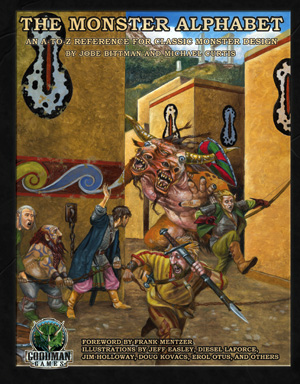This is a review of the supplement "The Monster Alphabet", written by Jobe Bittman and Michael Curtis, published by Goodman Games. It is a review of the print edition, which is a moderately slim hardcover, with a full color cover of some hapless-looking adventurers facing a freakishly mutant minotaur. The interior is black and white, and bristling with a considerable amount of the sort of gonzo fantasy art Goodman is by now famous for. The book is roughly 80 pages long.
The Monster Alphabet is quite an interesting product. I figured, at first glance at the cover, that it was going to be some kind of monster-manual type supplement, but that's not it at all. Instead, what we get, in gimmicky ABC-primer style, is a whole bunch of random table and options for modifying monsters and monster encounters and making things interesting. Obviously, the purpose is to enrich your old-school D&D play (though you could certainly use it with modern editions like 3.x or 5e, if what you want is to add some old-school flavor to those).
There's a foreword by Frank Mentzer (at least, I assume so, and that it's only a typo that declares the foreword to be by "Frank Menzer"), a drop-down table for monster features, and another foreword by Michael Curtis. None of these are all that interesting to read (no offense to Mr.Mentzer, or indeed to Mr.Menzer). But after that, we get into a bunch of very weird very awesome material.
So in brief, I'm going to give you the whole alphabet right here: A is for aquatic, armor, and android; B is for blood and breath weapon; C is for celestial, construct and crossbreed; D is for dragon; E for eyeball and extraplanar; F for flame; G for geas and giant; H for hoard; I for infernal and insectoid; J for jurassic; K for kryptonite; L for lair, lycanthrope, and lore; M for mimic and minions; N for noxious; O for ongoing damage, ooze lords and ordinary; P for psionic, plant and possessions; Q for quill; R for reaction, revenge and resistance; S for sorcery and sonic; T for tail; U for unexpected; V for vampire; W for weird and wings; X for xenotransplantation; Y for yuck; and Z for zombie and zoomorphic.
Each entry is one or two pages long, and usually features at least one random table. They present the reader with options along the theme of that entry. So for example, 'aquatic' gives you a table of aquatic attributes by which you can individualize your sea montster. "Blood" gives you a random table of special properties of monster blood (for eldritch purposes), another table with transmutations caused by exposure to monster blood, another with methods by which monster blood can be made to have a special effect, and yet another of 20 creature-types to which unusual blood-effects can be assigned.
"Eyes" gives you a table of weird qualities of effects a monster's eyes might have. "Hoard" gives you an unusual table for rolling up random magic items; while later on "Sorcery" includes tables for random weird book effects and random wands/rods/charms (as well as a random table for descriptive kooky appearances of wizards). "Lair" gives you a table of lair locations and a table of 'bases and bunkers'.
"Ordinary" acts as a kind of master design-key for the book. It has a table of regular monsters (the types you will find in a D&D monster manual), and then a table to determine which other section of the book to look at for how to modify them. "reaction" gives you a significantly expanded version of the classic D&D reaction table.
"Weird" is a section written by James Raggi (of Lamentations of the Flame Princess), and we're treated to one of his regular dull diatribes of his usual complaints about how 'mundane' D&D is when played by most people, and elaborating on his particular vision of 'weird fantasy'. True to Raggi form, his actual material is way way better than his blather, and he provides a d100 table of weird effects for monsters that has some very creative entries (the only thing to note about it is that unlike most of the other tables, this one has several entries that only make sense for Goodman's DCC system, and not other OSR/D&D games). Mind you, if ALL the monsters you encounter had one of these qualities (like Raggi advocates) then all the weird qualities would become boring and mundane. If every monster is 'weird', then none of them are, Raggi.
There are definitely some entries more interesting and useful than others. Some entries are little more than tables of descriptive detail with no real effects, while other entries are full of really interesting material with actual effects that changes a monster encounter beyond the purely aesthetic (for example, some new variations of breath weapons, types of geases, or flame-based powers).
In any case, on the whole, the Monster Alphabet is a fantastically useful product to spice up any OSR or D&D game, particularly if you want to move a little bit (or a lot, depending on how often you use the book) toward the Gonzo. There's already tons and tons of Monster Manuals out there, and frankly more of those are the last thing we need now. Instead, this lets you use the monster entries you undoubtedly already have access to, and inject them with a dose of novelty.
RPGPundit
Currently Smoking: Dunhill Shell Diplomat + C&D's Crowley's Best

Cool. For a second, I thought you were reviewing The Dungeon Alphabet. Glad I looked again.
ReplyDeleteAgreed, we need less monster manuals... and more random tables.
You didn't like the Dungeon Alphabet? I have both and like them both.
DeleteYou didn't like the Dungeon Alphabet? I have both and like them both.
Delete